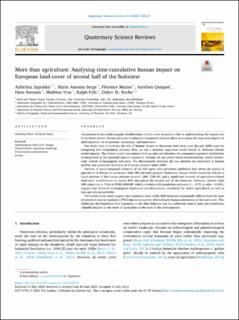| dc.contributor.author | Zapolska, Anhelina | |
| dc.contributor.author | Serge, Maria Antonia | |
| dc.contributor.author | Mazier, Florence | |
| dc.contributor.author | Quiquet, Aurélien | |
| dc.contributor.author | Renssen, Hans | |
| dc.contributor.author | Vrac, Mathieu | |
| dc.contributor.author | Fyfe, Ralph | |
| dc.contributor.author | Roche, Didier M. | |
| dc.date.accessioned | 2024-04-08T13:11:20Z | |
| dc.date.available | 2024-04-08T13:11:20Z | |
| dc.date.created | 2023-09-04T10:54:30Z | |
| dc.date.issued | 2023 | |
| dc.identifier.citation | Zapolska, A., Serge, M. A., Mazier, F., Quiquet, A., Renssen, H., Vrac, M., Fyfe, R., & Roche, D. M. (2023). More than agriculture: Analysing time-cumulative human impact on European land-cover of second half of the Holocene. Quaternary Science Reviews, 314, Artikkel 108227. | en_US |
| dc.identifier.issn | 0277-3791 | |
| dc.identifier.uri | https://hdl.handle.net/11250/3125338 | |
| dc.description.abstract | Assessment of past anthropogenic modifications of land-cover dynamics is key to understanding the human role in the Earth system. Recent advances in palaeoenvironmental sciences allow us to assess the long-term impacts of anthropization on ecosystems, landscapes, and land-cover.
Our study aims to evaluate the role of human impact on European land-cover over the past 6000 years by comparing two independent datasets. First, we use a dynamic vegetation model forced by debiased climate model outputs. The climate model uses natural forcings only and therefore the computed vegetation distribution is interpreted as the potential natural vegetation. Second, we use pollen-based reconstructions, which intrinsically include anthropogenic influence. The discrepancies between the two datasets are attributed to human activity and quantified in a form of a human pressure index (HPI).
Patterns of spatio-temporal evolution of the HPI agree with previously published data about the spread of agriculture in Europe. In particular, both HPI and anthropogenic land-cover change (ALCC) scenarios indicate a rapid increase of the human pressure around 1200–1700 BP, and a significant increase of agriculture-related land-cover modifications by nearly 60% throughout the second half of the Holocene. However, initially high HPI values (up to 70%) at 5700–6200 BP, which correlate with population estimates (r = 0.75, p-value <0.005), suggest high levels of anthropogenic land-cover transformations, introduced by earlier agricultural as well as non-agricultural activities.
The results of our study suggest that vegetation cover of the Mid-Holocene substantially differed from the state of potential natural vegetation (PNV) due to cumulative effect of early human alterations on the land-cover. This challenges the hypothesis that vegetation in the Mid-Holocene was in a relatively natural state and contributes valuable insights to the onset of agriculture as the start of the Anthropocene. | en_US |
| dc.language.iso | eng | en_US |
| dc.rights | Navngivelse 4.0 Internasjonal | * |
| dc.rights.uri | http://creativecommons.org/licenses/by/4.0/deed.no | * |
| dc.title | More than agriculture: Analysing time-cumulative human impact on European land-cover of second half of the holocene | en_US |
| dc.type | Peer reviewed | en_US |
| dc.type | Journal article | en_US |
| dc.description.version | publishedVersion | en_US |
| dc.rights.holder | © 2023 The Authors. | en_US |
| dc.source.volume | 314 | en_US |
| dc.source.journal | Quaternary Science Reviews | en_US |
| dc.identifier.doi | https://doi.org/10.1016/j.quascirev.2023.108227 | |
| dc.identifier.cristin | 2172020 | |
| dc.source.articlenumber | 108227 | en_US |
| cristin.ispublished | true | |
| cristin.fulltext | original | |
| cristin.qualitycode | 2 | |

